check engine light DODGE JOURNEY 2017 1.G User Guide
[x] Cancel search | Manufacturer: DODGE, Model Year: 2017, Model line: JOURNEY, Model: DODGE JOURNEY 2017 1.GPages: 510
Page 267 of 510
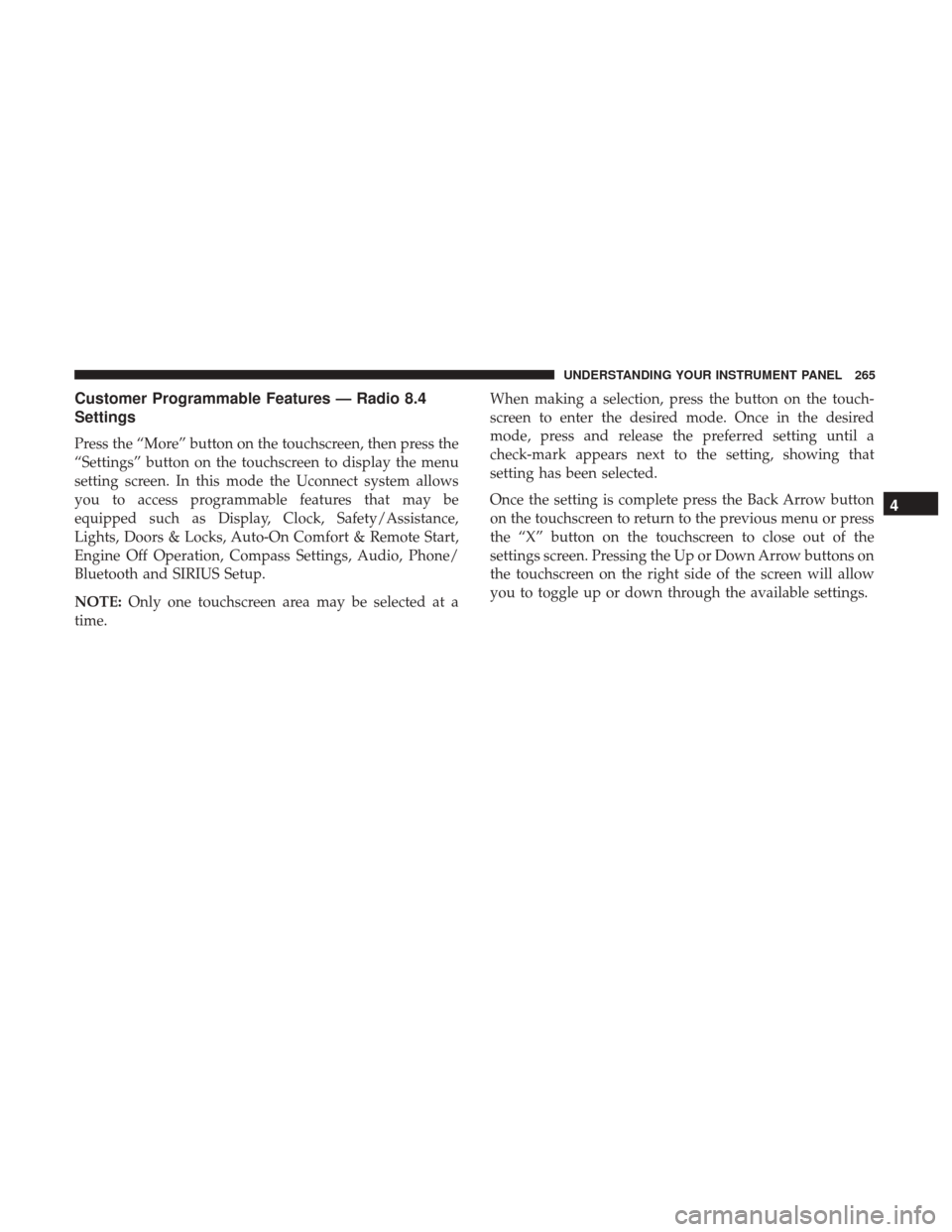
Customer Programmable Features — Radio 8.4
Settings
Press the “More” button on the touchscreen, then press the
“Settings” button on the touchscreen to display the menu
setting screen. In this mode the Uconnect system allows
you to access programmable features that may be
equipped such as Display, Clock, Safety/Assistance,
Lights, Doors & Locks, Auto-On Comfort & Remote Start,
Engine Off Operation, Compass Settings, Audio, Phone/
Bluetooth and SIRIUS Setup.
NOTE:Only one touchscreen area may be selected at a
time. When making a selection, press the button on the touch-
screen to enter the desired mode. Once in the desired
mode, press and release the preferred setting until a
check-mark appears next to the setting, showing that
setting has been selected.
Once the setting is complete press the Back Arrow button
on the touchscreen to return to the previous menu or press
the “X” button on the touchscreen to close out of the
settings screen. Pressing the Up or Down Arrow buttons on
the touchscreen on the right side of the screen will allow
you to toggle up or down through the available settings.
4
UNDERSTANDING YOUR INSTRUMENT PANEL 265
Page 341 of 510
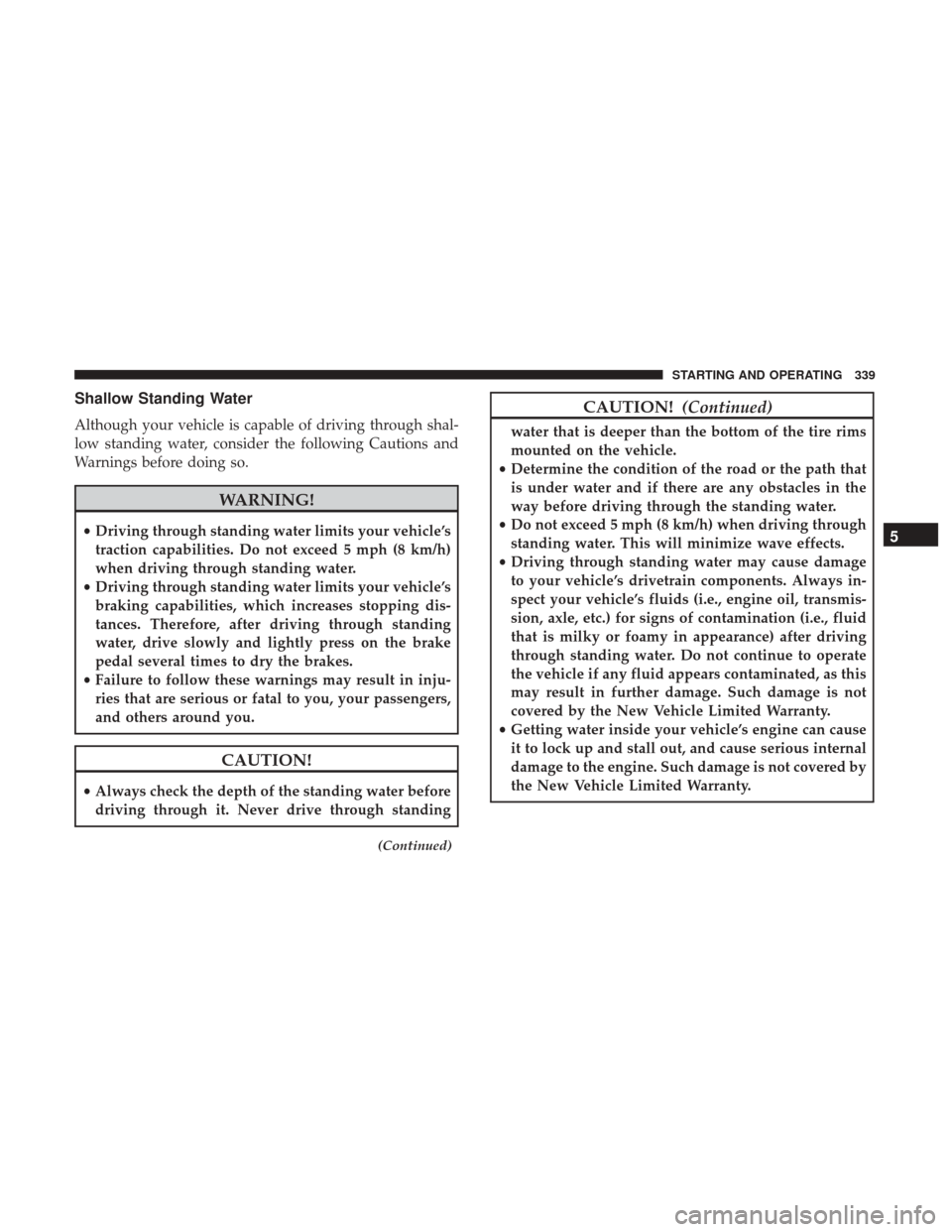
Shallow Standing Water
Although your vehicle is capable of driving through shal-
low standing water, consider the following Cautions and
Warnings before doing so.
WARNING!
•Driving through standing water limits your vehicle’s
traction capabilities. Do not exceed 5 mph (8 km/h)
when driving through standing water.
• Driving through standing water limits your vehicle’s
braking capabilities, which increases stopping dis-
tances. Therefore, after driving through standing
water, drive slowly and lightly press on the brake
pedal several times to dry the brakes.
• Failure to follow these warnings may result in inju-
ries that are serious or fatal to you, your passengers,
and others around you.
CAUTION!
• Always check the depth of the standing water before
driving through it. Never drive through standing
(Continued)
CAUTION! (Continued)
water that is deeper than the bottom of the tire rims
mounted on the vehicle.
• Determine the condition of the road or the path that
is under water and if there are any obstacles in the
way before driving through the standing water.
• Do not exceed 5 mph (8 km/h) when driving through
standing water. This will minimize wave effects.
• Driving through standing water may cause damage
to your vehicle’s drivetrain components. Always in-
spect your vehicle’s fluids (i.e., engine oil, transmis-
sion, axle, etc.) for signs of contamination (i.e., fluid
that is milky or foamy in appearance) after driving
through standing water. Do not continue to operate
the vehicle if any fluid appears contaminated, as this
may result in further damage. Such damage is not
covered by the New Vehicle Limited Warranty.
• Getting water inside your vehicle’s engine can cause
it to lock up and stall out, and cause serious internal
damage to the engine. Such damage is not covered by
the New Vehicle Limited Warranty.
5
STARTING AND OPERATING 339
Page 345 of 510
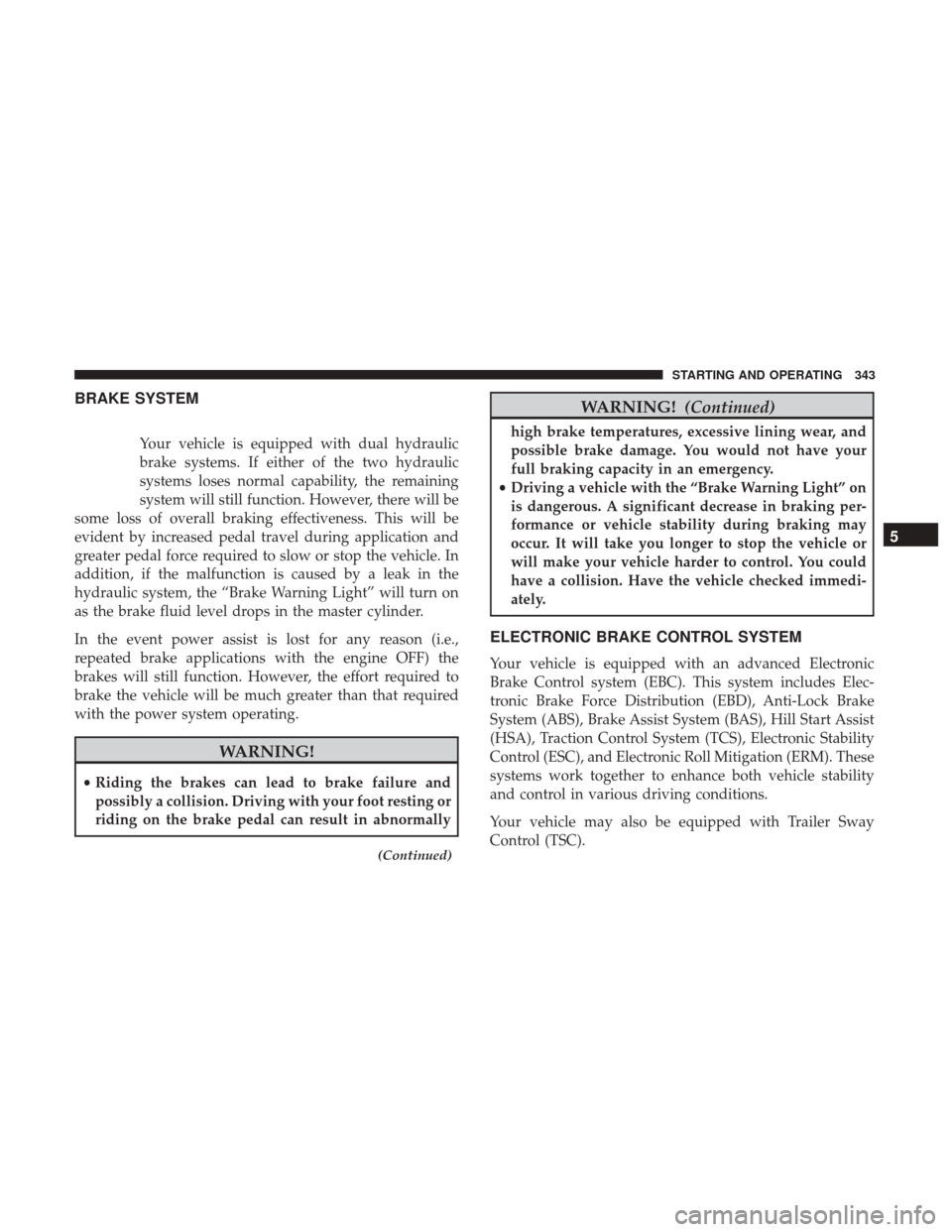
BRAKE SYSTEM
Your vehicle is equipped with dual hydraulic
brake systems. If either of the two hydraulic
systems loses normal capability, the remaining
system will still function. However, there will be
some loss of overall braking effectiveness. This will be
evident by increased pedal travel during application and
greater pedal force required to slow or stop the vehicle. In
addition, if the malfunction is caused by a leak in the
hydraulic system, the “Brake Warning Light” will turn on
as the brake fluid level drops in the master cylinder.
In the event power assist is lost for any reason (i.e.,
repeated brake applications with the engine OFF) the
brakes will still function. However, the effort required to
brake the vehicle will be much greater than that required
with the power system operating.
WARNING!
• Riding the brakes can lead to brake failure and
possibly a collision. Driving with your foot resting or
riding on the brake pedal can result in abnormally
(Continued)
WARNING! (Continued)
high brake temperatures, excessive lining wear, and
possible brake damage. You would not have your
full braking capacity in an emergency.
• Driving a vehicle with the “Brake Warning Light” on
is dangerous. A significant decrease in braking per-
formance or vehicle stability during braking may
occur. It will take you longer to stop the vehicle or
will make your vehicle harder to control. You could
have a collision. Have the vehicle checked immedi-
ately.
ELECTRONIC BRAKE CONTROL SYSTEM
Your vehicle is equipped with an advanced Electronic
Brake Control system (EBC). This system includes Elec-
tronic Brake Force Distribution (EBD), Anti-Lock Brake
System (ABS), Brake Assist System (BAS), Hill Start Assist
(HSA), Traction Control System (TCS), Electronic Stability
Control (ESC), and Electronic Roll Mitigation (ERM). These
systems work together to enhance both vehicle stability
and control in various driving conditions.
Your vehicle may also be equipped with Trailer Sway
Control (TSC).
5
STARTING AND OPERATING 343
Page 401 of 510
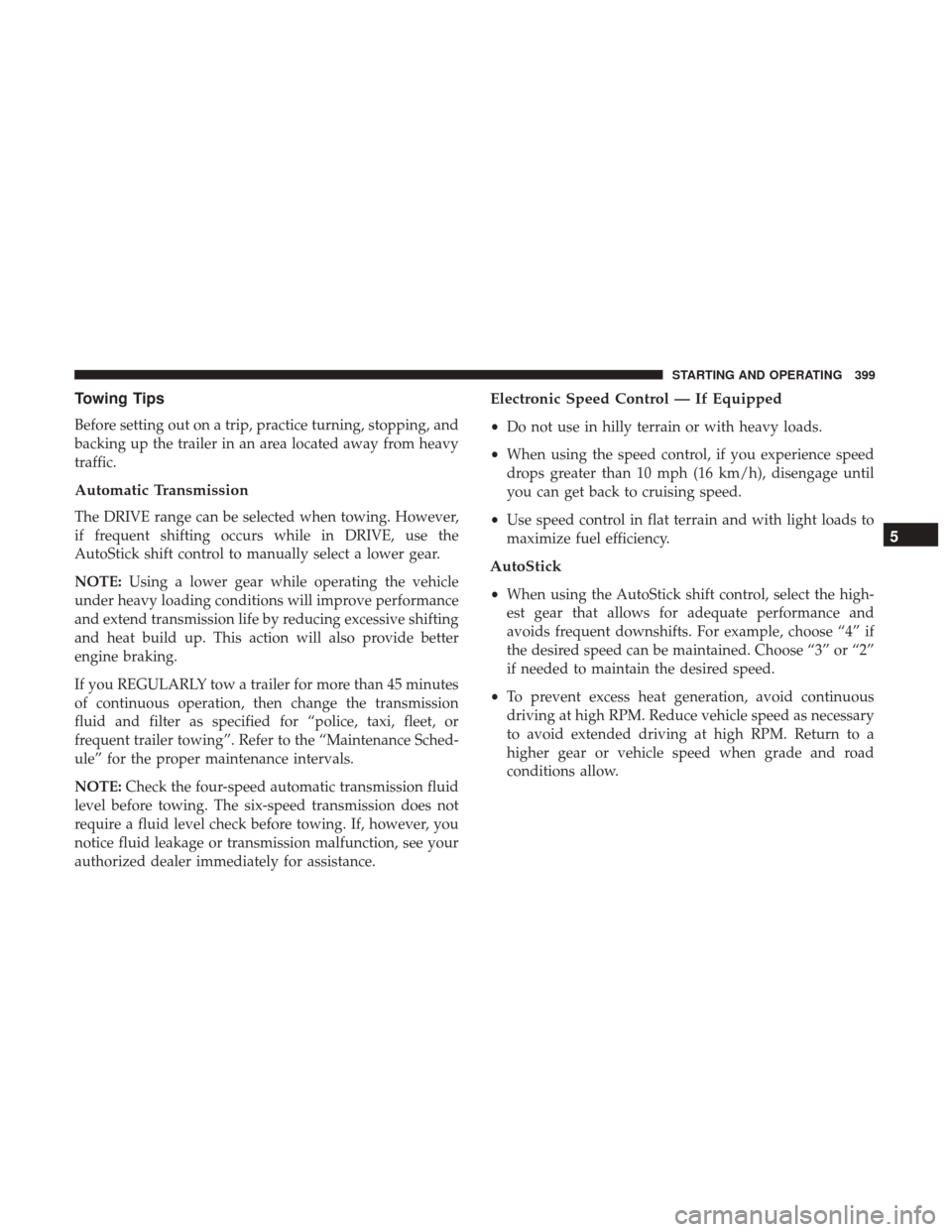
Towing Tips
Before setting out on a trip, practice turning, stopping, and
backing up the trailer in an area located away from heavy
traffic.
Automatic Transmission
The DRIVE range can be selected when towing. However,
if frequent shifting occurs while in DRIVE, use the
AutoStick shift control to manually select a lower gear.
NOTE:Using a lower gear while operating the vehicle
under heavy loading conditions will improve performance
and extend transmission life by reducing excessive shifting
and heat build up. This action will also provide better
engine braking.
If you REGULARLY tow a trailer for more than 45 minutes
of continuous operation, then change the transmission
fluid and filter as specified for “police, taxi, fleet, or
frequent trailer towing”. Refer to the “Maintenance Sched-
ule” for the proper maintenance intervals.
NOTE: Check the four-speed automatic transmission fluid
level before towing. The six-speed transmission does not
require a fluid level check before towing. If, however, you
notice fluid leakage or transmission malfunction, see your
authorized dealer immediately for assistance.
Electronic Speed Control — If Equipped
• Do not use in hilly terrain or with heavy loads.
• When using the speed control, if you experience speed
drops greater than 10 mph (16 km/h), disengage until
you can get back to cruising speed.
• Use speed control in flat terrain and with light loads to
maximize fuel efficiency.
AutoStick
• When using the AutoStick shift control, select the high-
est gear that allows for adequate performance and
avoids frequent downshifts. For example, choose “4” if
the desired speed can be maintained. Choose “3” or “2”
if needed to maintain the desired speed.
• To prevent excess heat generation, avoid continuous
driving at high RPM. Reduce vehicle speed as necessary
to avoid extended driving at high RPM. Return to a
higher gear or vehicle speed when grade and road
conditions allow.
5
STARTING AND OPERATING 399
Page 434 of 510
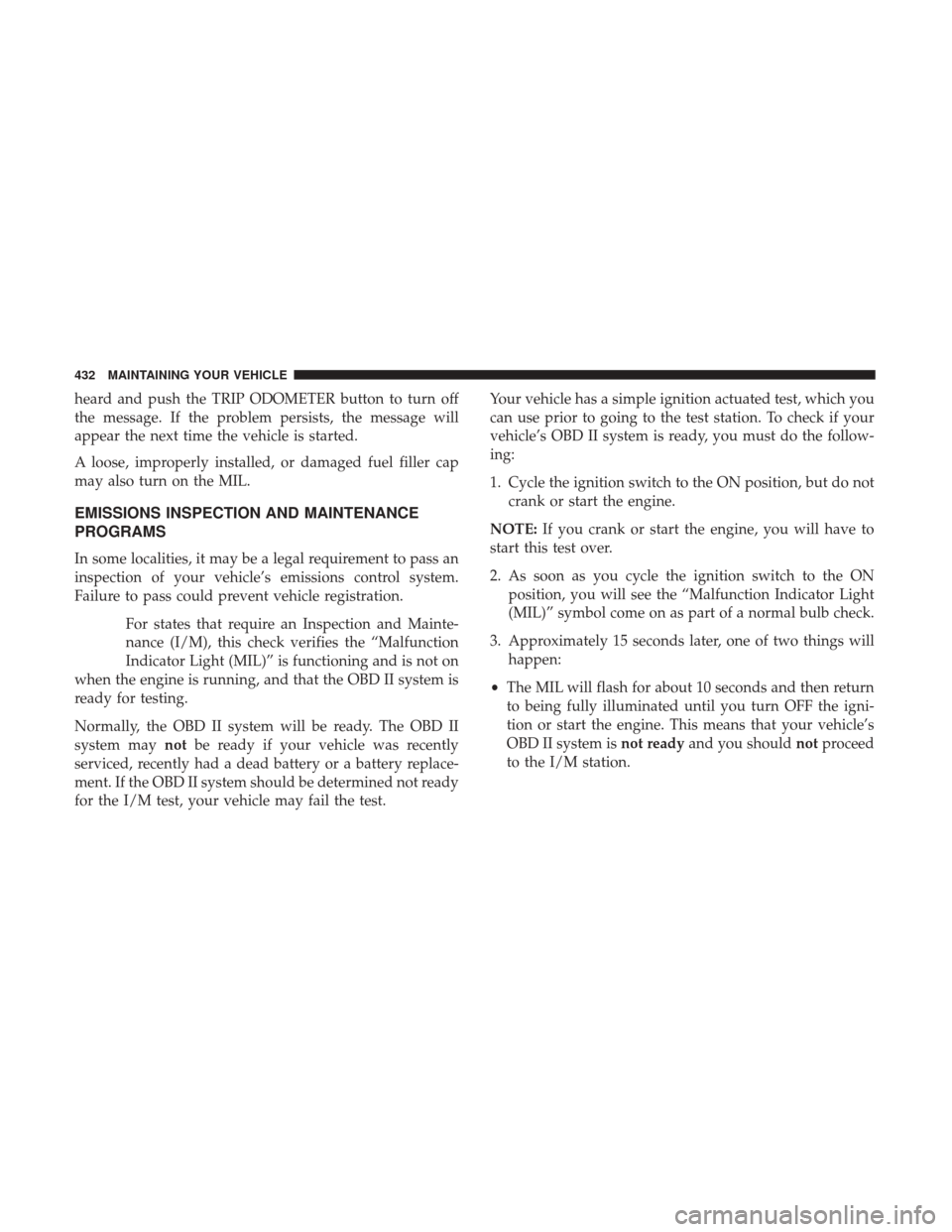
heard and push the TRIP ODOMETER button to turn off
the message. If the problem persists, the message will
appear the next time the vehicle is started.
A loose, improperly installed, or damaged fuel filler cap
may also turn on the MIL.
EMISSIONS INSPECTION AND MAINTENANCE
PROGRAMS
In some localities, it may be a legal requirement to pass an
inspection of your vehicle’s emissions control system.
Failure to pass could prevent vehicle registration.For states that require an Inspection and Mainte-
nance (I/M), this check verifies the “Malfunction
Indicator Light (MIL)” is functioning and is not on
when the engine is running, and that the OBD II system is
ready for testing.
Normally, the OBD II system will be ready. The OBD II
system may notbe ready if your vehicle was recently
serviced, recently had a dead battery or a battery replace-
ment. If the OBD II system should be determined not ready
for the I/M test, your vehicle may fail the test. Your vehicle has a simple ignition actuated test, which you
can use prior to going to the test station. To check if your
vehicle’s OBD II system is ready, you must do the follow-
ing:
1. Cycle the ignition switch to the ON position, but do not
crank or start the engine.
NOTE: If you crank or start the engine, you will have to
start this test over.
2. As soon as you cycle the ignition switch to the ON position, you will see the “Malfunction Indicator Light
(MIL)” symbol come on as part of a normal bulb check.
3. Approximately 15 seconds later, one of two things will happen:
• The MIL will flash for about 10 seconds and then return
to being fully illuminated until you turn OFF the igni-
tion or start the engine. This means that your vehicle’s
OBD II system is not readyand you should notproceed
to the I/M station.
432 MAINTAINING YOUR VEHICLE
Page 480 of 510
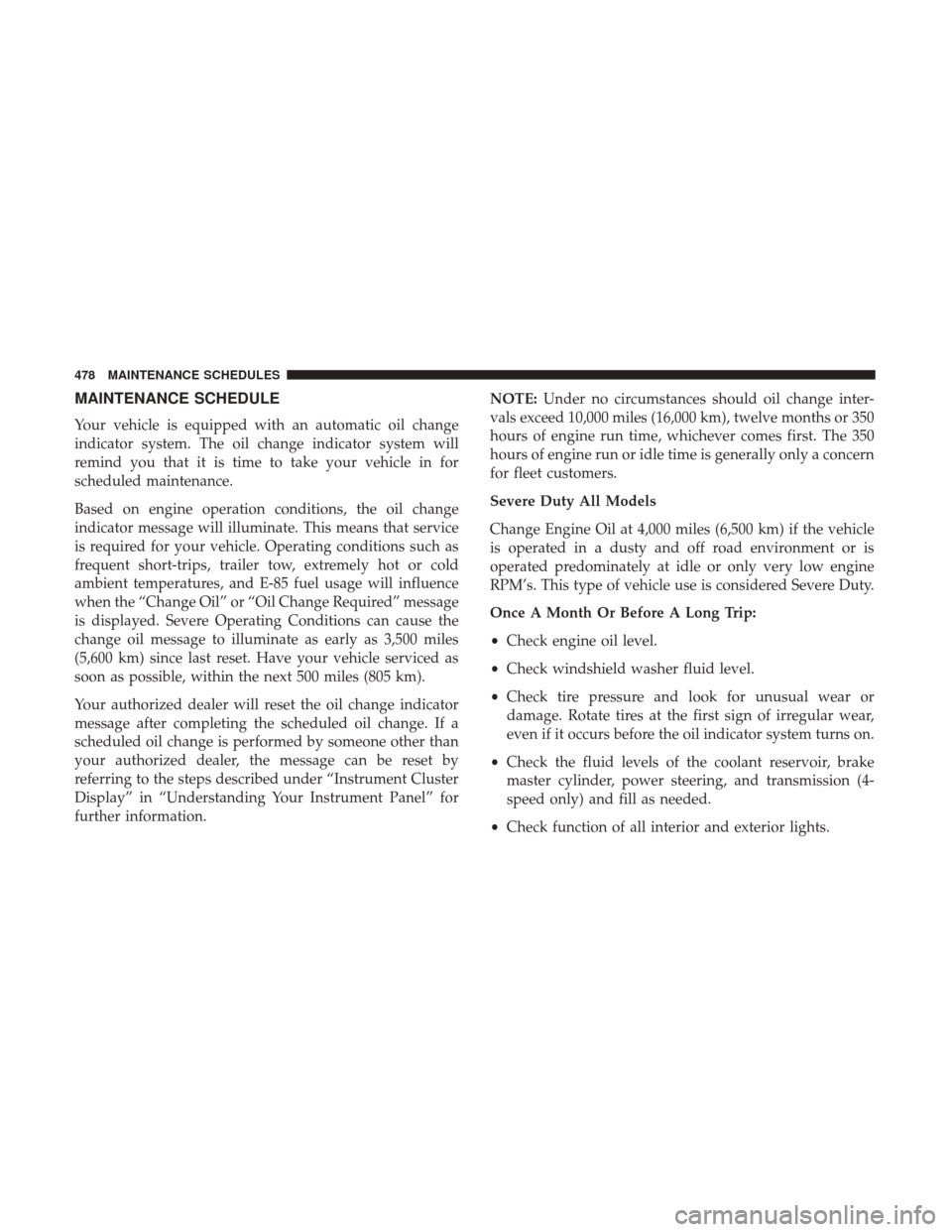
MAINTENANCE SCHEDULE
Your vehicle is equipped with an automatic oil change
indicator system. The oil change indicator system will
remind you that it is time to take your vehicle in for
scheduled maintenance.
Based on engine operation conditions, the oil change
indicator message will illuminate. This means that service
is required for your vehicle. Operating conditions such as
frequent short-trips, trailer tow, extremely hot or cold
ambient temperatures, and E-85 fuel usage will influence
when the “Change Oil” or “Oil Change Required” message
is displayed. Severe Operating Conditions can cause the
change oil message to illuminate as early as 3,500 miles
(5,600 km) since last reset. Have your vehicle serviced as
soon as possible, within the next 500 miles (805 km).
Your authorized dealer will reset the oil change indicator
message after completing the scheduled oil change. If a
scheduled oil change is performed by someone other than
your authorized dealer, the message can be reset by
referring to the steps described under “Instrument Cluster
Display” in “Understanding Your Instrument Panel” for
further information.NOTE:
Under no circumstances should oil change inter-
vals exceed 10,000 miles (16,000 km), twelve months or 350
hours of engine run time, whichever comes first. The 350
hours of engine run or idle time is generally only a concern
for fleet customers.
Severe Duty All Models
Change Engine Oil at 4,000 miles (6,500 km) if the vehicle
is operated in a dusty and off road environment or is
operated predominately at idle or only very low engine
RPM’s. This type of vehicle use is considered Severe Duty.
Once A Month Or Before A Long Trip:
• Check engine oil level.
• Check windshield washer fluid level.
• Check tire pressure and look for unusual wear or
damage. Rotate tires at the first sign of irregular wear,
even if it occurs before the oil indicator system turns on.
• Check the fluid levels of the coolant reservoir, brake
master cylinder, power steering, and transmission (4-
speed only) and fill as needed.
• Check function of all interior and exterior lights.
478 MAINTENANCE SCHEDULES
Page 493 of 510
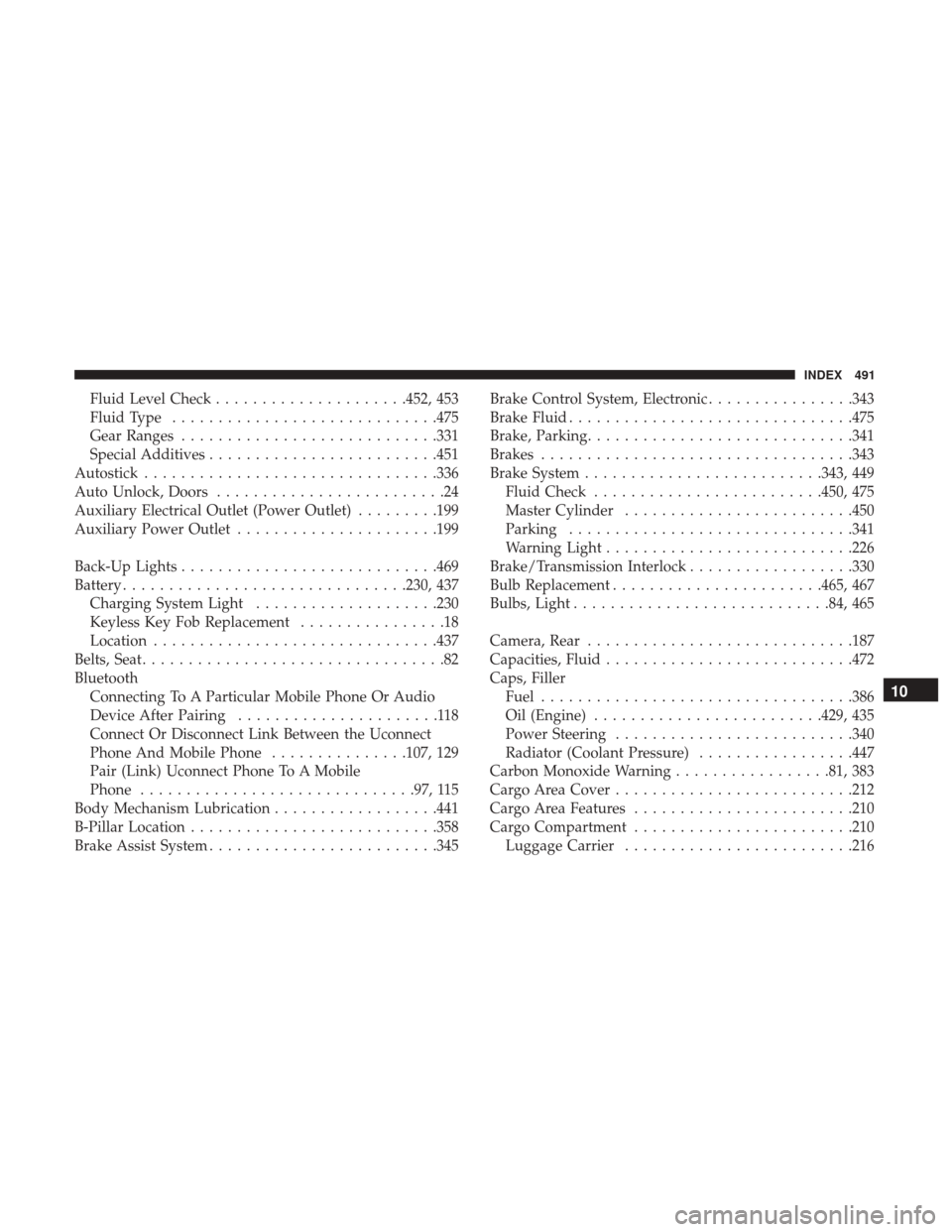
Fluid Level Check.....................452, 453
Fluid Type ............................ .475
Gear Ranges ........................... .331
Special Additives ........................ .451
Autostick ............................... .336
Auto Unlock, Doors .........................24
Auxiliary Electrical Outlet (Power Outlet) .........199
Auxiliary Power Outlet ..................... .199
Back-Up Lights ........................... .469
Battery .............................. .230, 437
Charging System Light ....................230
Keyless Key Fob Replacement ................18
Location .............................. .437
Belts, Seat .................................82
Bluetooth Connecting To A Particular Mobile Phone Or Audio
Device After Pairing ......................118
Connect Or Disconnect Link Between the Uconnect
Phone And Mobile Phone ...............107, 129
Pair (Link) Uconnect Phone To A Mobile
Phone ............................. .97, 115
Body Mechanism Lubrication ..................441
B-Pillar Location .......................... .358
Brake Assist System ........................ .345Brake Control System, Electronic
................343
Brake Fluid .............................. .475
Brake, Parking ............................ .341
Brakes ................................. .343
Brake System ......................... .343, 449
Fluid Check ........................ .450, 475
Master Cylinder ........................ .450
Parking .............................. .341
Warning Light .......................... .226
Brake/Transmission Interlock ..................330
Bulb Replacement ...................... .465, 467
Bulbs, Light ........................... .84, 465
Camera, Rear ............................ .187
Capacities, Fluid .......................... .472
Caps, Filler Fuel ................................. .386
Oil
(Engine) ........................ .429, 435
Power Steering ......................... .340
Radiator (Coolant Pressure) .................447
Carbon Monoxide Warning .................81, 383
Cargo Area Cover ......................... .212
Cargo Area Features ....................... .210
Cargo Compartment ....................... .210
Luggage Carrier ........................ .21610
INDEX 491
Page 494 of 510
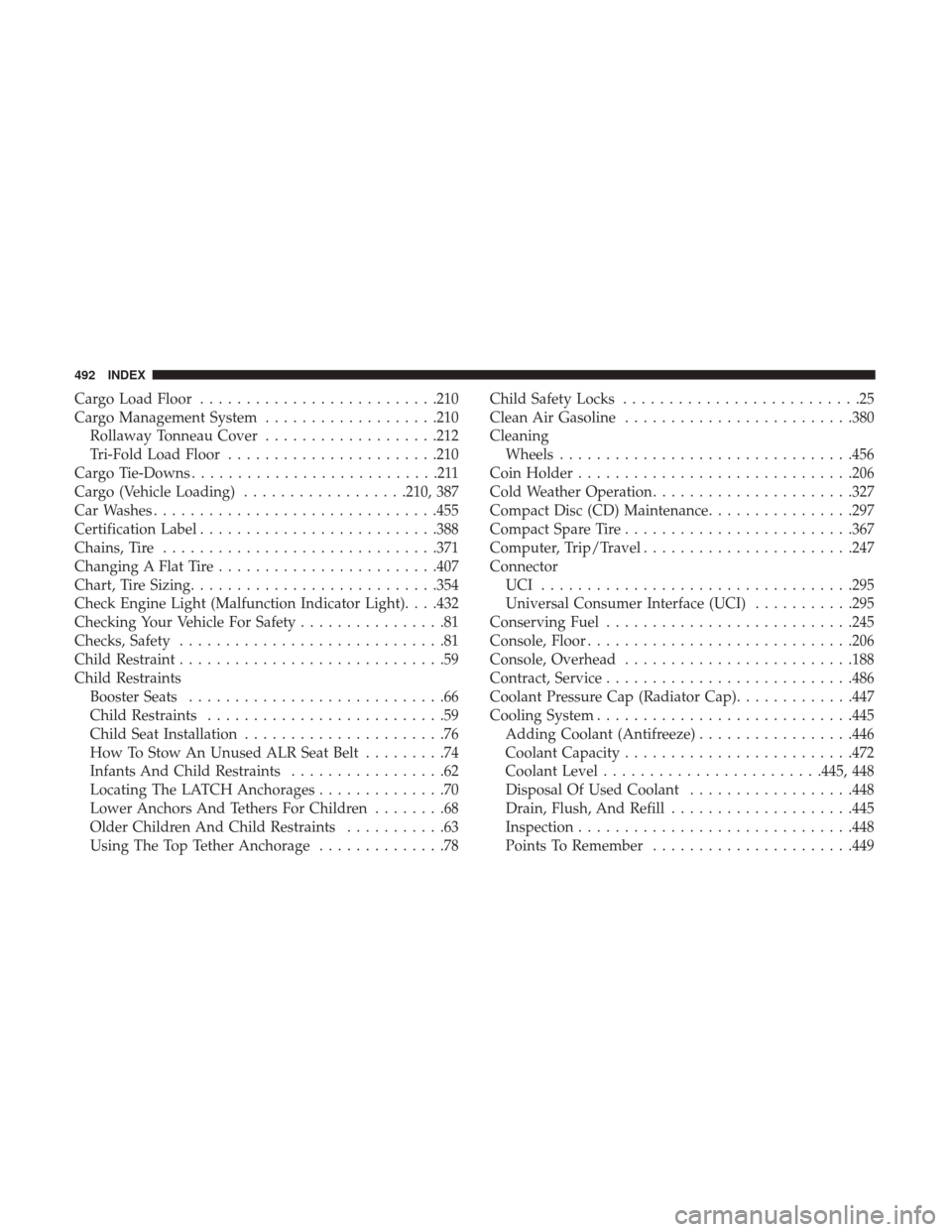
Cargo Load Floor......................... .210
Cargo Management System ...................210
Rollaway Tonneau Cover ...................212
Tri-Fold Load Floor ...................... .210
Cargo Tie-Downs ...........................211
Cargo (Vehicle Loading) ..................210, 387
Car Washes .............................. .455
Certification Label ......................... .388
Chains, Tire ............................. .371
Changing A Flat Tire ....................... .407
Chart, Tire Sizing .......................... .354
Check Engine Light (Malfunction Indicator Light). . . .432
Checking Your Vehicle For Safety ................81
Checks, Safety .............................81
Child Restraint .............................59
Child Restraints Booster Seats ............................66
Child Restraints ..........................59
Child Seat Installation ......................76
How To Stow An Unused ALR Seat Belt .........74
Infants And Child Restraints .................62
Locating The LATCH Anchorages ..............70
Lower Anchors And Tethers For Children ........68
Older Children And Child Restraints ...........63
Using The Top Tether Anchorage ..............78Child Safety Locks
..........................25
Clean Air Gasoline ........................ .380
Cleaning Wheels ............................... .456
Coin Holder ............................. .206
Cold Weather Operation ..................... .327
Compact Disc (CD) Maintenance ................297
Compact Spare Tire ........................ .367
Computer, Trip/Travel ...................... .247
Connector UCI ................................. .295
Universal Consumer Interface (UCI) ...........295
Conserving Fuel .......................... .245
Console, Floor ............................ .206
Console, Overhead ........................ .188
Contract, Service .......................... .486
Coolant Pressure Cap (Radiator Cap) .............447
Cooling
System........................... .445
Adding Coolant (Antifreeze) .................446
Coolant Capacity ........................ .472
Coolant Level ....................... .445, 448
Disposal Of Used Coolant ..................448
Drain, Flush, And Refill ....................445
Inspection ............................. .448
Points To Remember ..................... .449
492 INDEX
Page 496 of 510
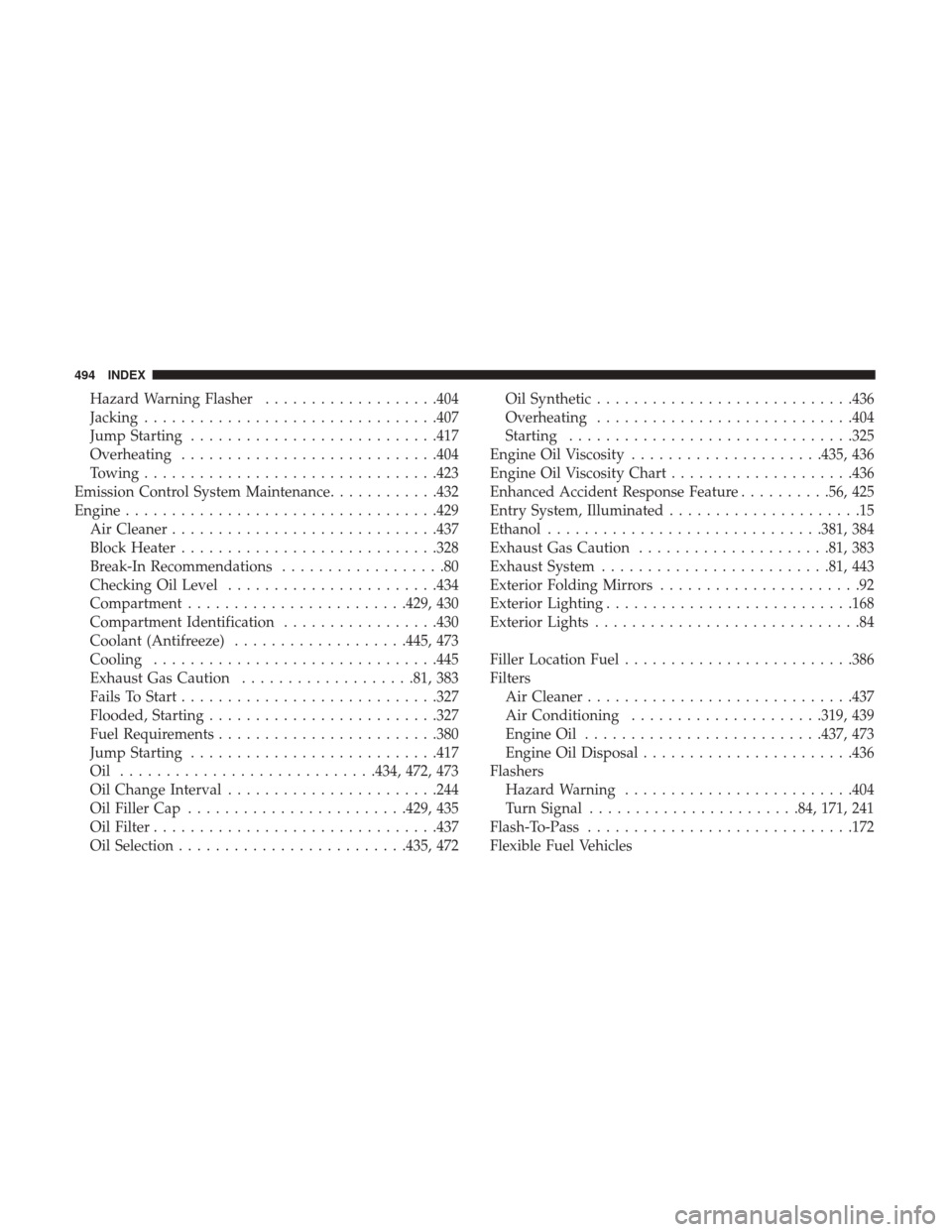
Hazard Warning Flasher...................404
Jacking ............................... .407
Jump Starting .......................... .417
Overheating ........................... .404
Towing ............................... .423
Emission Control System Maintenance ............432
Engine ................................. .429
Air Cleaner ............................ .437
Block Heater ........................... .328
Break-In Recommendations ..................80
Checking Oil Level ...................... .434
Compartment ....................... .429, 430
Compartment Identification .................430
Coolant (Antifreeze) ...................445, 473
Cooling .............................. .445
Exhaust Gas Caution ...................81, 383
Fails To Start ........................... .327
Flooded, Starting ........................ .327
Fuel Requirements ....................... .380
Jump Starting .......................... .417
Oil ........................... .434, 472, 473
Oil Change Interval ...................... .244
Oil Filler Cap ....................... .429, 435
Oil Filter .............................. .437
Oil Selection ........................ .435, 472Oil Synthetic
........................... .436
Overheating ........................... .404
Starting .............................. .325
Engine Oil Viscosity .....................435, 436
Engine Oil Viscosity Chart ....................436
Enhanced Accident Response Feature ..........56, 425
Entry System, Illuminated .....................15
Ethanol ............................. .381, 384
Exhaust Gas Caution .....................81, 383
Exhaust System ........................ .81, 443
Exterior
Folding Mirrors ......................92
Exterior Lighting .......................... .168
Exterior Lights .............................84
Filler Location Fuel ........................ .386
Filters Air Cleaner ............................ .437
Air Conditioning .....................319, 439
Engine Oil ......................... .437, 473
Engine Oil Disposal ...................... .436
Flashers Hazard Warning ........................ .404
Turn Signal ...................... .84, 171, 241
Flash-To-Pass ............................ .172
Flexible Fuel Vehicles
494 INDEX
Page 497 of 510
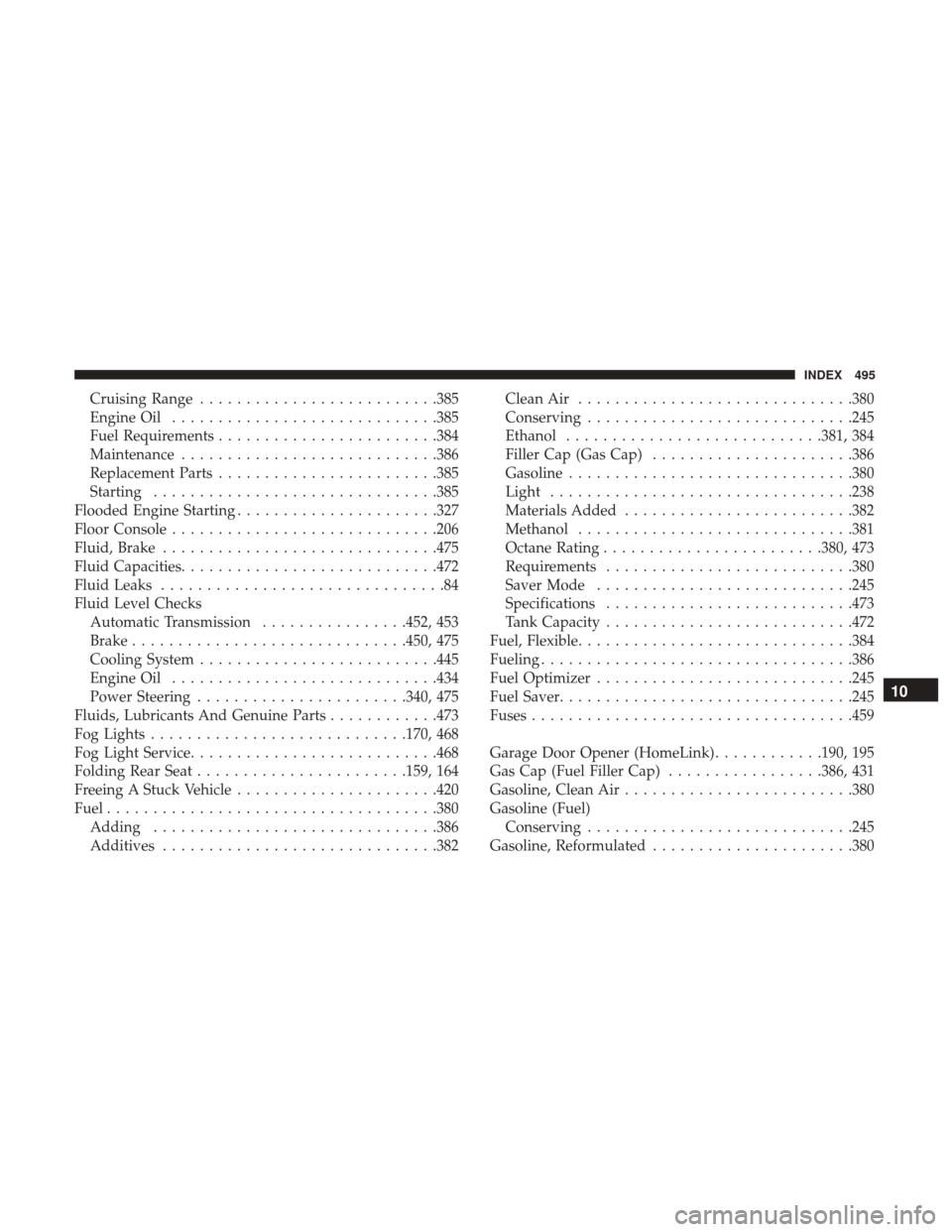
Cruising Range......................... .385
Engine Oil ............................ .385
Fuel Requirements ....................... .384
Maintenance ........................... .386
Replacement Parts ....................... .385
Starting .............................. .385
Flooded Engine Starting ..................... .327
Floor Console ............................ .206
Fluid, Brake ............................. .475
Fluid Capacities ........................... .472
Fluid Leaks ...............................84
Fluid Level Checks Automatic Transmission ................452, 453
Brake ............................. .450, 475
Cooling System ......................... .445
Engine Oil ............................ .434
Power Steering ...................... .340, 475
Fluids, Lubricants And Genuine Parts ............473
Fog Lights ........................... .170, 468
Fog Light Service .......................... .468
Folding Rear Seat ...................... .159, 164
Freeing A Stuck Vehicle ..................... .420
Fuel ................................... .380
Adding .............................. .386
Additives ............................. .382Clean Air
............................. .380
Conserving ............................ .245
Ethanol ........................... .381, 384
Filler Cap (Gas Cap) ..................... .386
Gasoline .............................. .380
Light ................................ .238
Materials Added ........................ .382
Methanol ............................. .381
Octane Rating ....................... .380, 473
Requirements .......................... .380
Saver
Mode ........................... .245
Specifications .......................... .473
Tank Capacity .......................... .472
Fuel, Flexible ............................. .384
Fueling ................................. .386
Fuel Optimizer ........................... .245
Fuel Saver............................... .245
Fuses .................................. .459
Garage Door Opener (HomeLink) ............190, 195
Gas Cap (Fuel Filler Cap) .................386, 431
Gasoline, Clean Air ........................ .380
Gasoline (Fuel) Conserving ............................ .245
Gasoline, Reformulated ..................... .380
10
INDEX 495